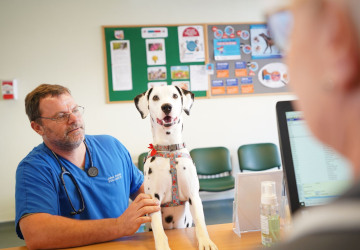
Understanding your dog with Edgewood Vets
June 14, 2018
We’ve all heard dogs ‘talk’ – from excited barks to warning woofs to play-growls. But often it’s the non-verbal communication that is most important. It can be tough to work out what your dog is trying to tell you, so the team at Edgewood Vets has gathered a list of common dog behaviours with an explanation of what they might mean.
If your dog exhibits a behaviour that’s not on our list, or you’re still unsure why it does what it does, our head nurse Caroline is a fount of knowledge and happy to pass that on when you contact us.
Contact us for advice on dog behaviour
1. Head tilting
Your dog may be:
- Trying to hear better with a particular ear.
- Empathising with you – trying to filter out words they recognise.
- Trying to get to get a better look at something, because their muzzle may block their view.
2. Sniffing
Dogs’ sense of smell is around 1,000 times greater than ours and it’s one of the main ways they navigate the world. It’s also how they identify each other and their owners, which is why they head for areas that secrete the most concentrated scents. It might seem inappropriate, but they’re just enjoying your ‘perfume’.
3. Tail wagging
You may think this simply signals a happy, friendly dog, but it can also mean uncertainty, fear, insecurity, a social challenge or even a warning.
4. Digging
Some breeds are born diggers, but for others digging could be a sign of searching for food, entertainment or attention. They may even be trying to escape from something if they’re scared.
5. Shoe chewing
Chewing’s a normal part of a dog exploring the world, but can also be caused by instinct, boredom or anxiety or because it’s seeking extra nutrients.
6. Whining or whimpering
Once you’ve ruled out pain or injury, it could be your pet is asking for a bathroom break, is expressing submission, excitement, anxiety, frustration, or fear.
7. Licking
Dogs love sweaty, salty skin. We usually respond by hugging or stroking them, which is positive reinforcement they will seek more of. It can also be a sign of submission.
If you’re still unsure of what your dog’s trying to tell you, simply call us on 01621 828381 and Caroline will be happy to offer advice.






